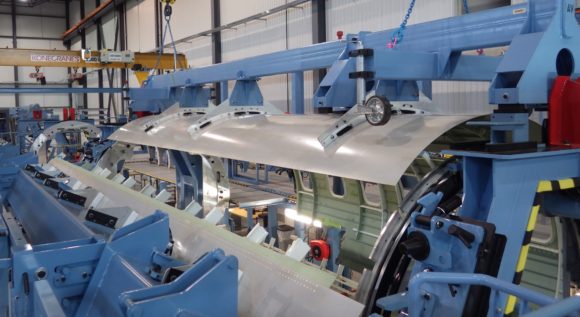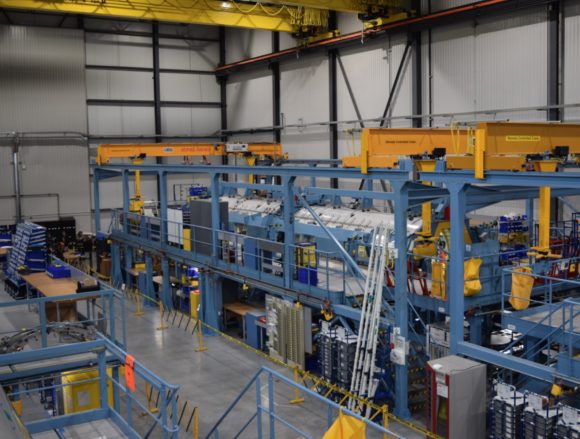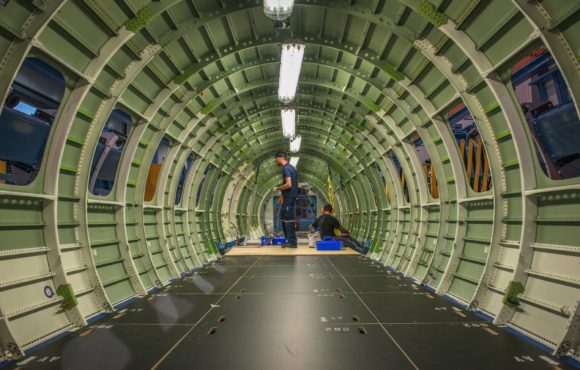We had the opportunity to visit Stelia Aerospace during Aerospace Week in Montreal and tour their operations at Mirabel. Stelia Aerospace is a wholly-owned subsidiary of Airbus that specializes in aerostructures, premium cabin seating, and pilot seats for commercial and business aircraft. The facility in Mirabel, Quebec is dedicated to the assembly of the center fuselage for the Bombardier Global 7500.
Stelia grew out of a merger of two Airbus companies, SOGERMA, that specialized in maintenance and seats, and Aerolia, which specialized in building aerostructures and was an Airbus spin off of two facilities. Stelia employs nearly 7,000 people worldwide, with major facilities in France, about 2/3rds of its activities, as well as Morocco and Canada, and has annual revenues of €2.2 billion.
Leveraging advanced technology, the company employs the latest generation of manufacturing robots, has large autoclaves for composite production, both moving and carousel lines for A320 and A350 cockpits and structures, real-time supply chain management, digital production support, digital mock-ups, manufacturing augmented reality support, and inspection cobots in its various facilities.
In Mirabel, the facility specializes on one program, the Global 7500, and will assemble the Global 8000 fuselage when it is introduced as well. Approximately 250 employees assemble the fuselages, which when finished are “plug and play” products, fully outfitted with all of the systems, including electronics and wiring and hydraulic systems. The 73,000 sq. ft. facility has a capacity to produce 77 Global 7500 fuselages annually, and the site has room to expand 5 times the size of the current facility. Clearly, Stelia intends to be a major player in North America bidding for additional aerostructure programs in the future.
The Fuselage Assembly Process at Mirabel
The process begins by attaching several pieces to form the fuselage structures, attaching two half fuselages into a single unit, and finishing the installation of systems into the fuselage before delivery to Downsview in Toronto for final assembly at Bombardier.
The front and rear shells arrive from a Stelia facility in Rochefort in France, with some sub-assembly panels from Stelia facilities in Meaulte, France or Tunisia. The assembly process follows a U-shaped line. The initial station assembles the fuselage from component parts.
The finished barrels then move to a second station at which brackets for systems and furnishing are installed. This process includes about 3,000 brackets, and the fuselage is laser measured to extremely close tolerances to enable the “plug and play” process for joining and systems attachment.
From there, the fuselage is moved to the bottom of the U and is primed in a paint booth.
The second half of the U-shaped line is dedicated to systems installation and inspection. While full systems testing is performed at Bombardier, installation and inspection of systems takes up nearly half of the time a fuselage is in process at Stelia. Wiring harnesses, plumbing for hydraulics, and connectors for the integration with the cockpit and tail cone are installed and inspected.
The Stelia facility in Mirabel has been in operation since 2015. Production ramp-up has been successful, and Stelia is currently building fuselage number 52 to meet the demand from Bombardier as it increases Global 7500 production. The assembly process, including the installation of systems, requires strong supply-chain management and operational precision to ensure that everything fits together smoothly on the final assembly line. Stelia has now managed the ramp-up and is ready to produce at full capacity to meet demand from Bombardier.
The Bottom Line
Stelia now provides Airbus Group with a fully capable aerostructures assembly facility in North America, and can compete with Spirit and others for future aerostructures work. With a strong and stable workforce, a strong management team headed by Jean-Pierre Cousserans, and room to expand at Mirabel, Stelia is well positioned for future growth.
Views: 88







